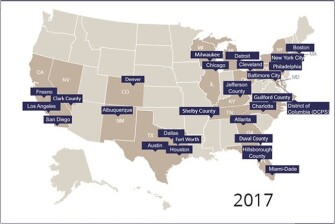
America’s large urban districts have been improving faster than the nation as a whole, and mostly held onto those gains during the latest National Assessment of Educational Progress in reading and mathematics.
“We know we need to accelerate the pace of reform and improvement in our urban schools, and we know our achievement gaps are still too wide,” said Michael Casserly, the executive director of the Council of the Great City Schools at a symposium on the NAEP district results here Tuesday afternoon, “but these NAEP data give us the tools we need to ask hard questions about our instructional practices and where we need to improve.”
The Trial Urban District Assessment, a close snapshot of more than two dozen of the country’s largest school districts, is part of the NAEP, whose results were released Tuesday.
This year, the National Center for Education Statistics, which administers the NAEP, also reported a separate measure of progress for all “large city” school districts with more than 250,000 students. Students in large city districts still trail the national average, but seem to be closing some of the gaps:
- For example, on average, public school 8th graders have only improved in math by 2 scale points in the last decade, to 282 out of 500. Urban 8th graders, meanwhile, improved by 5 scale points, to 274.
- At 4th grade, national math scores were flat at 239, while urban students’ scores rose 2 points, to 232.
- Nationwide, 4th grade reading scores have inched up 1 point in the last decade, to 221, while urban students’ scores rose by 5 points, to 213.
- At 8th grade reading, national scores rose by 4 points since 2007, to 265, while urban students’ scores rose a whopping 8 points, to 258.
Those gains are a mixed blessing: Urban 4th graders scored on average at the basic level in math and reading. Urban 8th graders scored on average at the basic level in reading and below basic in math. Yet, 27 percent of urban 8th graders scored at or above the proficient level in reading in 2017, up 8 percentage points since 2007. That’s faster than the 5 percentage-point reading growth for students overall.
“We’re not where we want to be, but there has been some tremendous progress there,” said Peggy Carr, NCES’ associate commissioner for assessment.
Trial Districts Expand
The 2017 NAEP added five new districts to its Trial Urban District Assessment: Clark County, Nev.; Denver; Fort Worth, Texas; Guilford County, N.C.; and Shelby County, Tenn. Taken together, the 27 urban districts in the study represent more than half of all U.S. 4th and 8th graders.
“We say we want our students to be competitive in a global society, so we need to know how they are measuring up with their peers across the nation,” said LaTanya McDade, the chief education officer of Chicago Public Schools, one of the longest-running TUDA participants, which had flat scores in both grades and subjects in 2017. “We want to be able to take a critical look at ourselves, ... and to have integrity.”
In math, the Duval County and Miami-Dade districts helped push Florida’s overall 4th grade gains. California’s Fresno school district likewise improved in math in 4th grade, while San Diego was the only district to improve in both reading and math at 4th grade. Albuquerque and Boston also improved in 8th grade reading compared to their 2015 test results. A new NAEP site provides more detail on the results in math and reading.
Miami-Dade Superintendent Alberto Carvalho said his district has focused on improving preschool and early learning, as well as encouraging more disadvantaged students to participate in challenging coursework. Cindy Marten, the San Diego schools superintendent, seconded the need to align improvement across grades pre-K-12.
“Really, what you see in 8th grade starts in early literacy. Third grade reading has been a major goal for our district, because it tees us up for important achievement in 8th grade,” Marten said. “You can’t wait until middle school to make this happen.”
The San Diego district brings teachers from multiple grades together to create common formative assessments to provide early warnings of students who begin to struggle during the elementary to middle grades.
“We also have to focus on literacy throughout all the years,” Marten said. “What does it mean to be literate in middle school, and are all of our middle school teachers competent at understanding reading practices and behaviors. ... What does it mean to be able to read, write, compute, and engage in multiple forms of literacy at the middle level?”
Each TUDA district was chosen both for its overall size and for having large enough populations of students in traditionally disadvantaged groups—including black or Hispanic students and students in poverty—to provide valid results.
“Today’s results are a reminder that the path to meaningfully improving student achievement runs through the daily work happening in classrooms between teachers and students,” said Michael Cohen,the president of the school reform group Achieve. “Teachers and administrators need robust support to implement higher standards; there must be a substantial, ongoing effort to continuously improve the quality of curriculum and the capacity of schools—particularly those serving the most disadvantaged students—to ensure that kids can meet the higher standards that states have set and that the real world demands.”
Graphic: Twenty-seven large school districts participate in the NAEP’s Trial Urban District Assessment, or TUDA. Source: National Center for Education Statistics.
Related:
